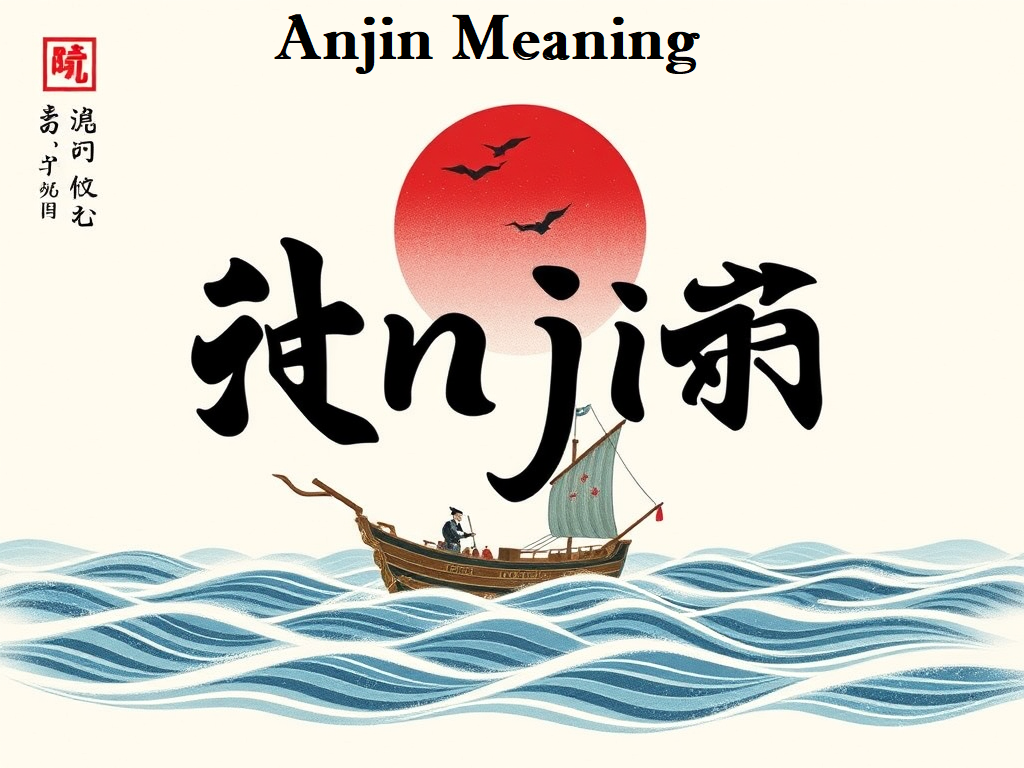The term Anjin (安針) holds a profound place in Japanese history and culture, representing far more than its literal translation might suggest. This fascinating word has evolved from a simple naval term to become a symbol of cultural bridge building, leadership, and trust between East and West. Understanding the Anjin meaning in Japanese requires delving into centuries of history, examining its connections to the samurai class, and exploring its continued relevance in modern Japan.
What is “Anjin”?
Anjin (安針) is a Japanese term that literally means “pilot” or “navigator” in English. The word is composed of two kanji characters: 安 (An), meaning “peace” or “safe,” and 針 (Jin), meaning “needle” or “compass.” Together, these characters create a concept that goes beyond simple navigation—they represent someone who guides others safely through dangerous waters, both literally and metaphorically.
The Anjin pronunciation follows standard Japanese phonetics: “AHN-jeen,” with equal emphasis on both syllables. This term carries significant historical significance as it became forever linked with one of the most remarkable figures in Japanese history.
Linguistic Structure and Meaning
The construction of Anjin kanji reveals deep cultural insights:
- 安 (An): Represents safety, peace, and security
- 針 (Jin): Symbolizes direction, precision, and guidance
When combined, these characters create a word that embodies the concept of trustworthy guidance through uncertain circumstances. This linguistic foundation helps explain why Anjin became such a respected title in Japanese society.
Anjin in Historical Context
The historical context of Anjin is inseparable from Japan’s Edo Period (1603-1868), a time when the country was simultaneously isolating itself from most foreign contact while selectively engaging with certain Western influences. During this era, the role of a pilot or navigator held immense importance, as these individuals possessed crucial knowledge for safe sea travel and international commerce.
The term gained its most famous association through William Adams, an English sailor who arrived in Japan in 1600 aboard the Dutch ship Liefde. Adams became the first Western samurai and was granted the honorary title Miura Anjin by Tokugawa Ieyasu, the founder of the Tokugawa shogunate.
The Edo Period Context
During the Edo Period, Japan maintained a complex relationship with foreign nations:
| Period | Policy | Foreign Contact |
|---|---|---|
| Early Edo (1603-1633) | Limited openness | Dutch, Portuguese, English traders |
| Sakoku (1633-1853) | National isolation | Only Dutch and Chinese in Nagasaki |
| Late Edo (1853-1868) | Forced opening | Increasing Western influence |
This historical backdrop makes the story of Anjin particularly remarkable, as it represents one of the few instances of successful cross-cultural relations during a period of increasing isolation.
Cultural Importance of Anjin
The cultural importance of Anjin extends far beyond its literal meaning as a navigator. In Japanese society, the concept represents several key values:
Trust forms the foundation of the Anjin concept. A navigator must be completely trusted with the lives of everyone aboard a vessel. This trust extends to broader contexts of leadership and guidance in Japanese culture.
Competence is another crucial aspect. The Anjin must possess not only technical knowledge but also the wisdom to make sound decisions under pressure. This requirement for proven ability makes the title one of respect and honor.
Cultural bridge building represents perhaps the most significant aspect of Anjin in Japanese culture. The historical Anjin served as intermediaries between Japanese and foreign cultures, facilitating understanding and cooperation.
Modern Cultural Interpretations
Contemporary Japanese culture continues to value the principles embodied by Anjin:
- Leadership through service rather than dominance
- Integrity in all dealings and relationships
- Guidance based on wisdom and experience
- Trustworthiness as a fundamental character trait
The Samurai Connection
The connection between Anjin and the samurai class represents one of the most fascinating aspects of this term’s history. William Adams, known as Anjin-san, became the first Western samurai, demonstrating how the principles of navigation and bushido (the way of the warrior) could complement each other.
Bushido and Navigation
The samurai code of bushido emphasized several principles that aligned perfectly with the qualities required of an Anjin:
Honor (名誉 – Meiyo): Both samurai and navigators needed unimpeachable reputations to be trusted with important responsibilities.
Courage (勇 – Yu): Facing unknown waters or battlefields required similar types of bravery and determination.
Loyalty (忠義 – Chugi): Samurai served their lords just as navigators served their crews and passengers.
Strategic thinking: Both roles required the ability to assess situations quickly and make decisive choices under pressure.
The Hatamoto Status
William Adams was granted hatamoto status, making him a direct retainer of the Shōgun. This exceptional honor demonstrates how highly the Japanese valued the Anjin‘s contributions:
- Fief meaning: Adams received a fief worth 250 koku of rice annually
- Hatamoto meaning: Direct vassal of the Shōgun with significant privileges
- Samurai rights: Full warrior class status with two swords privilege
Anjin in Art and Pop Culture
The figure of Anjin has captured imaginations across various forms of media and artistic expression. Most notably, James Clavell’s novel “Shōgun” brought the story of Anjin-san to international attention, though with considerable creative liberty taken with historical facts.
Literature and Media Representations
“Shōgun” by James Clavell:
- Published in 1975, this novel dramatized the story of William Adams
- Shōgun meaning in the context of the novel refers to military dictator
- Shōgun cast from various adaptations has included acclaimed actors
- Shōgun Season 2 discussions continue among fans
The novel’s impact on popular understanding of Anjin cannot be overstated. Many people’s first encounter with the term comes through this literature and media representation, though it’s important to note that the book takes significant dramatic license with historical events.
Cultural Representation in Modern Media
Contemporary Japanese media continues to reference Anjin in various contexts:
- Historical dramas (大河ドラマ – Taiga Drama)
- Educational documentaries
- Cultural exchange programs
- Business leadership seminars
The Anjin Connection Within the Samurai Upheld Culture: Anjin Meaning
The integration of Anjin into samurai culture represents a unique moment in Japanese history where foreign expertise was not only accepted but elevated to the highest levels of society. This connection reveals important aspects of how Japanese culture has historically approached valuable knowledge and skills, regardless of their origin.
Cultural Integration Principles
The successful integration of Anjin into samurai culture followed several key principles:
Merit-based recognition: Skills and knowledge were valued regardless of cultural background when they proved beneficial to Japanese interests.
Adaptation and learning: Japanese leaders showed willingness to learn from foreign expertise while maintaining their cultural identity.
Mutual respect: The relationship between Tokugawa Ieyasu and William Adams demonstrated how mutual respect could overcome cultural barriers.
Strategic value: The practical benefits of navigation and Western knowledge were recognized and incorporated into Japanese strategic thinking.
Modern Usage and Adaptations of “Anjin”
In contemporary Japan, Anjin is rarely used in everyday conversation, but it maintains significance in specific contexts. The modern usage of the term has evolved to encompass broader concepts of leadership and guidance.
Contemporary Applications
Business contexts: Modern Japanese companies sometimes use Anjin metaphorically to describe leaders who guide organizations through challenging periods.
Educational settings: The concept appears in leadership training programs and cultural education courses.
International relations: Anjin symbolizes Japan’s approach to cultural exchange and diplomatic navigation.
Tourism and culture: Historical sites related to William Adams use the term to attract visitors and educate about cross-cultural relations.
Symbolic Modern Interpretations
| Context | Modern Meaning | Application |
|---|---|---|
| Business | Strategic guide | Corporate leadership |
| Education | Cultural mentor | Exchange programs |
| Diplomacy | Bridge builder | International relations |
| Tourism | Historical symbol | Cultural heritage sites |
What Does “Anjin” as a Word Mean?
The word Anjin encompasses multiple layers of meaning that extend far beyond its literal translation. Does Anjin mean barbarian or pilot? This common question reflects confusion that sometimes arises, but Anjin definitively means pilot or navigator, not barbarian.
Comprehensive Definition
Primary meaning: Pilot, navigator, or helmsman
Secondary meanings:
- Guide or leader
- Someone who provides direction
- Cultural intermediary
- Trusted advisor
Symbolic meanings:
- Wisdom in decision-making
- Reliability under pressure
- Cultural bridge between different groups
- Strategic thinking and planning
How do you write Anjin in Japanese?
Anjin is written as 安針 in kanji. The characters can also be written in hiragana as あんじん or katakana as アンジン, though the kanji form is most common in formal contexts.
Meaning, Usage, and Context of “Anjin”
Understanding the full meaning, usage, and context of Anjin requires examining how the term functions in different situations and time periods.
Historical Usage Patterns
Edo Period (1603-1868):
- Formal title for navigators and pilots
- Specific reference to William Adams as Miura Anjin
- Symbol of successful foreign integration
Meiji Period (1868-1912):
- Less common as Japan modernized its navy
- Historical reference point for cultural exchange
- Symbol of Japan’s selective adoption of Western knowledge
Modern Era (1912-present):
- Primarily historical and cultural reference
- Metaphorical usage in leadership contexts
- Symbol of trust and competence
Contextual Variations
The usage of Anjin varies significantly depending on context:
Formal historical references: Used when discussing William Adams or navigation history
Cultural discussions: Employed to represent successful cultural exchange and mutual respect
Leadership contexts: Applied metaphorically to describe effective guidance and strategic thinking
Educational settings: Used to teach about Japanese history and cross-cultural relations
Principal Personages Relating to The Anjin
While William Adams remains the most famous Anjin, several other historical figures contributed to the development and understanding of this concept.
William Adams (“Anjin-san”)
William Anjin, born around 1564 in Gillingham, England, became the most celebrated Anjin in Japanese history. His remarkable story encompasses:
Early Life and Journey:
- Born into a maritime family
- Served as apprentice to shipbuilders
- Joined the Dutch expedition that reached Japan in 1600
Arrival in Japan:
- Reached Japan aboard the Liefde on April 19, 1600
- Initially imprisoned but later released
- Became the first Western samurai
Integration into Japanese Society:
- Learned Japanese language and customs
- Married a Japanese woman, Oyuki
- Established a Japanese family alongside his English family
Professional Achievements:
- Served as advisor to Tokugawa Ieyasu
- Built Japan’s first Western-style ships
- Facilitated early cross-cultural relations
Other Notable Figures
Jan Joosten van Lodensteijn: Another crew member of the Liefde who also gained prominence in Japan, though not with the Anjin title.
Tokugawa Ieyasu: The Shōgun who recognized William Adams‘ value and granted him samurai status and the Anjin title.
Miura Yoshimoto: The Japanese lord whose name Adams adopted, becoming Miura Anjin.
The Impact of “Anjin” Today
The legacy of Anjin continues to influence contemporary Japanese society and international relations in several meaningful ways.
Educational Impact
Japanese schools teach the story of Anjin as part of their history curriculum, emphasizing:
- The importance of cultural exchange
- Trust building between different cultures
- The value of competence over cultural background
- Historical examples of successful integration
Cultural Tourism
Several locations in Japan commemorate the Anjin legacy:
Ito City: Home to the Anjin Festival and William Adams memorial Yokosuka: Location of Adams‘ grave and historical markers Tokyo: Various museums featuring Anjin exhibitions Nagasaki: Historical context of early foreign contact
Business and Leadership Applications
Modern Japanese business culture often references Anjin principles:
Trust-based leadership: Building relationships through demonstrated competence and reliability
Cultural navigation: Successfully managing international business relationships
Strategic guidance: Providing direction during uncertain times
Cross-cultural competence: Bridging differences between diverse groups
“Anjin” in the Context of International Relations
The concept of Anjin provides valuable insights into Japan’s approach to international relations, both historically and in contemporary times.
Historical Diplomatic Lessons
The success of William Adams as Anjin demonstrates several key principles that continue to influence Japanese diplomacy:
Mutual benefit: Relationships work best when both parties gain value
Cultural respect: Understanding and adapting to local customs while maintaining core identity
Long-term thinking: Building relationships that endure beyond immediate circumstances
Practical value: Demonstrating concrete benefits through actions and results
Modern International Applications
Contemporary Japan applies Anjin principles in various international contexts:
Economic partnerships: Building trust through consistent, reliable behavior
Cultural exchange programs: Facilitating mutual understanding between different societies
Diplomatic negotiations: Using strategic thinking and cultural sensitivity
International cooperation: Serving as a cultural bridge in multilateral relationships
Anjin the Representation of Trust and Etiquette
Why do they call him Anjin? The title Anjin was bestowed upon William Adams because he demonstrated the essential qualities associated with the role: trustworthiness, competence, and the ability to navigate complex situations successfully.
Trust as a Foundation
Trust forms the cornerstone of the Anjin concept. In Japanese culture, trust is not merely given but must be earned through consistent demonstration of:
Reliability: Consistently meeting obligations and expectations Honesty: Truthfulness in all communications and dealings
Competence: Demonstrating the skills and knowledge necessary for the role Loyalty: Commitment to the welfare of those being served
Etiquette and Cultural Sensitivity
The Anjin must master not only technical skills but also cultural etiquette:
Language proficiency: William Adams learned Japanese to communicate effectively
Social customs: Understanding and respecting Japanese traditions and hierarchies
Diplomatic skills: Navigating complex political and social relationships
Cultural adaptation: Integrating foreign knowledge with local practices
What does Anjin-sama mean in Japanese?
Anjin-sama represents the highest form of respect for someone holding the Anjin title. The addition of “sama” (様) is an honorific suffix indicating great respect and reverence. This form would typically be used when referring to a highly respected Anjin or in formal, ceremonial contexts.
Conclusion
The Anjin meaning in Japanese encompasses far more than a simple translation of “pilot” or “navigator.” This remarkable term represents a unique intersection of trust, competence, cultural exchange, and leadership that continues to resonate in modern Japan and international relations.
From its origins as a naval term to its elevation through the extraordinary story of William Adams, Anjin has become a symbol of successful cross-cultural relations and the power of demonstrated competence to transcend cultural boundaries. The connection between Anjin and the samurai class illustrates how Japanese culture could adapt and integrate valuable foreign knowledge while maintaining its essential character.
The historical significance of Anjin extends beyond individual achievement to represent broader principles of mutual respect, strategic thinking, and cultural bridge building that remain relevant in today’s interconnected world. Whether applied in business leadership, international diplomacy, or cultural exchange programs, the principles embodied by Anjin continue to provide valuable guidance for navigating complex relationships and circumstances.
Understanding Anjin offers insights not only into Japanese history and culture but also into timeless principles of leadership, trust, and cross-cultural relations that transcend national boundaries and historical periods. The legacy of Anjin reminds us that competence, integrity, and cultural sensitivity can overcome even the most significant barriers to understanding and cooperation.
FAQs about “Anjin”:
What is the meaning of the name “Anjin?”
Anjin (安針) literally means “pilot” or “navigator” in Japanese. The name combines two kanji characters: 安 (An) meaning “peace” or “safe,” and 針 (Jin) meaning “needle” or “compass.” Together, they represent someone who guides others safely through dangerous waters.
Where does the word Anjin come from?
The word Anjin originates from Japanese maritime terminology, combining ancient kanji characters that represent safety and guidance. It gained prominence during the Edo Period when applied to William Adams, the first Western samurai.
What is the best known “Anjin”?
William Adams, known as Miura Anjin or Anjin-san, is by far the most famous Anjin. This English navigator became the first Western samurai and served as advisor to Tokugawa Ieyasu in early 17th century Japan.
What does “Anjin-san” mean in the book Shōgun?
In James Clavell’s novel “Shōgun,” Anjin-san refers to the protagonist based on William Adams. The “san” suffix is a respectful honorific, making Anjin-san equivalent to “Mr. Pilot” or “Pilot-san” in English.
Is “Anjin” used in modern Japanese?
Anjin is rarely used in everyday modern Japanese conversation. It appears primarily in historical context, literature and media, cultural education, and occasionally as a metaphor for leadership and guidance in business contexts.
What is the symbolic meaning of “Anjin”?
Symbolically, Anjin represents trust, competence, cultural bridge building, leadership through service, and the ability to navigate complex situations successfully. It embodies the principles of reliability, strategic thinking, and cross-cultural understanding.
Is “Anjin” a name or a title?
Anjin functions as both a title and can be used as part of a name. Historically, it was primarily a title indicating the role of pilot or navigator. William Adams received “Miura Anjin” as both a title and part of his Japanese name, with Miura being the family name he adopted and Anjin indicating his role and status.

Catherine Frank, founder of BiblicalHorizon.com, shares daily prayers and Bible verses to nurture spiritual growth. With a lifelong passion for scripture and prayer traditions, she creates accessible spiritual content that resonates with both seasoned believers and newcomers seeking divine connection.



